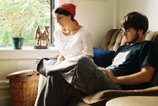

FEELING
Art in Seattle
The mechanical woman in our GPS keeps telling us “you have arrived” in such a flat emotionless voice that we are starting to believe her positivism. Last Friday as we drove home under a crescent moon our windshield filled with rain like tears, an orange sky, the Olympics stretched out like a homemade slinky right in front of us. We spent the evening at the Bellevue Art Fair looking for art that was true in its own quiet way: tree trunk sculptures, transparent glass figures with haunting expressions and missing brains, rubber skins molded by human mouths, alternate universes for miniature aliens made of gold, and more Nick Cave sound suits, since as Deleuze says: “Art preserves, and it is the only thing in the world that is preserved.” The Bellevue Art Museum, is Seattle’s Brooklyn Museum, only without the large obsession with Hudson River School paintings. We like it a lot.
Otherwise, Seattle is “waging a war on cars” according to Elizabeth Campbell, a local anti-biking mayoral candidate with a gift for noting positive developments. “They put in bikeways that get in the way,” she said, referring to current city planners. We tried out some of those bikeways a bit last night (walking our bikes down hills that were too steep). We tried not to get in the way and yet be brave like actual travelers. And we did fine, all the way down to the Gasworks Park, a retired oil refinery, where the ducks hide their heads in their feathers, little Chinese girls flap like birds, and kites fly high.
We watched a couple struggling to sail a little yacht in Lake Union and squinted when the sunlight reflecting off of the buildings downtown was too bright, over-exposing our eyeballs and making everything light. Thankfully, we might not have our own yacht or our own bicycle built for two, but we have two bikes and we can ride them together just fine, funny helmets or not. Next weekend we are going to throw a Frisbee at the park up 15th Avenue and admire the little redwood grove by the stream and the dogs which howl in harmony with emergent sirens.
"Preserve" by John Grade and "Untitled (woman in lace)" by Judy Hill














